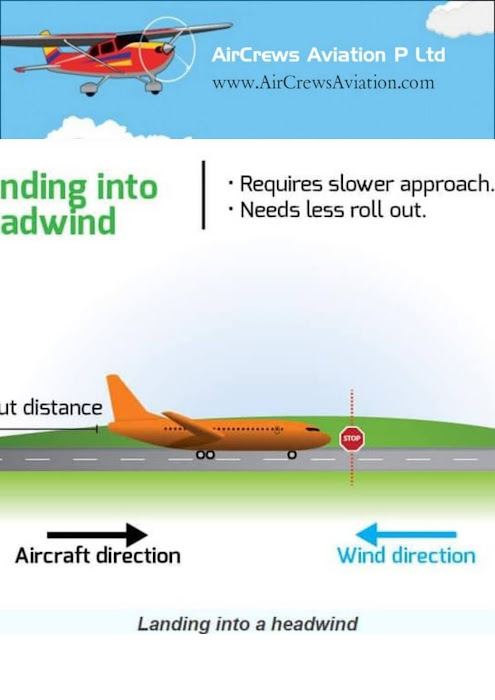Wind Factor (Aircraft Performance) - Basic
Wind Factor (Aircraft Performance) - Basic
Most aircraft accidents occur during the take-off and landing phase of the flight. Collisions with obstacles during climb out, runway overruns on landing occur every now and then. On this section of the site we will take a look at the various factors contributing to the performance of the aircraft in this part of the flight. Hopefully we help the pilot ensuring safe operation during these phases of the flight as the rules require that of the pilot in command.
The effect of wind has on our aircraft is something we can influence to some extend. We can choose runways with the greatest headwind component (when the airport has more than one runway) and use the wind on our tails when flying to our destination. Windspeed and direction usually changes with altitude so that effect can be used too.
The last part of the flight (landings) can be the most demanding for the pilot, and during training he/she will spend a lot of time practicing these to almost perfection.
Wind factor (Aircraft Performance) - Basic
Most aircraft accidents occur during the take-off and landing phase of the flight. Collisions with obstacles during climb out, runway overruns on landing occur every now and then. On this section of the site we will take a look at the various factors contributing to the performance of the aircraft in this part of the flight. Hopefully we help the pilot ensuring safe operation during these phases of the flight as the rules require that of the pilot in command.
The effect of wind has on our aircraft is something we can influence to some extend. We can choose runways with the greatest headwind component (when the airport has more than one runway) and use the wind on our tails when flying to our destination. Windspeed and direction usually changes with altitude so that effect can be used too.
The last part of the flight (landings) can be the most demanding for the pilot, and during training he/she will spend a lot of time practicing these to almost perfection.
1) Headwinds & Tailwinds
Aircraft use the flow of wind over the wings to generate lift to be able to fly. A minimum amount is required to lift-off and usually the engine generates thrust to obtain this lift-off speed.
*Headwind
By taking off into the wind (the wind will generate part of the required lift) the aircraft lifts off sooner and this will result in a lower ground speed and therefore a shorter take-off run for the aircraft to become airborne. It is therefore recommended.
Not only for safety reasons: a take-off that is abandoned will also use less runway to stop because ground speed is lower (check the ASDA distance during preflight). Climbing into the wind will result in a steeper climb, which is ideal for clearing obstacles in your climb out path.
Landing into the wind has the same advantages, it uses less runway, ground speed is lower at touchdown (less wear and tear on the aircraft) and the runway is available sooner for the next aircraft when it gets a bit crowded.
A rule of thumb says that take-off and landing distances are reduced 1,5 % for each knot of headwind up to 20 knots.
*Tailwind
Take-offs with a tailwind will result in the use of much more runway to get enough lift for flight (It takes distance to nullify the tailwind before any headwind is obtained for lift). Climb angle is also reduced. Think about obstacles! A five knot tailwind increase take-off distance with 25% and a ten knot tailwind with about 55%.
The same can be said about landing distances. The main reasons for executing tailwind operations could be airport noise abatement procedures or commercial operations and in case of certain mountain airports where you land up slope and take-off down slope again.
**Landing
Landing with a tailwind has another problem: you will approach the runway with a higher ground speed and this could lead the pilot into lowering his airspeed because he/she is visually accustomed to a lower ground speed. At this point a stall can happen, with no room to recover from it. But the solution is simple: be aware of this problem and concentrate a bit more and fly your usual indicated final approach speed and expect to use more runway.
During landing the best thing to do is to avoid tailwinds altogether, only if sufficient runway and pilot experience is available it can be done safely.
Remember: tailwinds do not lower the indicated airspeed or stall speed, they influence the ground speed of the aircraft.
**Turbulent Gusting Winds
Aircraft Performance, Tailwind
On take-off with gusting winds it will be required that you keep the aircraft on the ground somewhat longer to provide a higher margin from the stall. During landing you must add half the gust factor to your final approach speed. Thus if tower reports the wind 240 at 18 gusts 28 it is advisable to add 5 kts to your airspeed.
**Gust Factor
It is wise to do the same on take-off. Add half the gust factor to your normal lift-off speed, this should provide a safe margin from the stall. Keep in mind that because of these higher take-off and approach speeds more distance on the runway is required so with short runways this technique may not be ideal.







Comments
Post a Comment